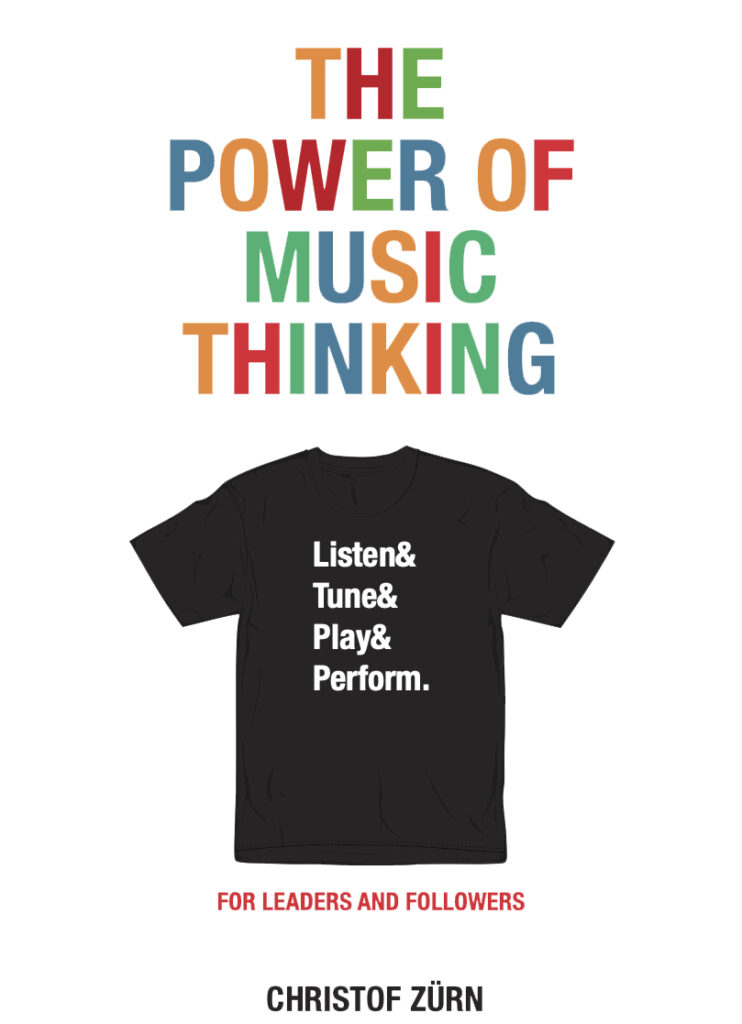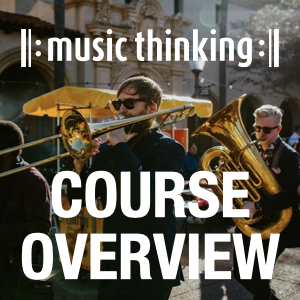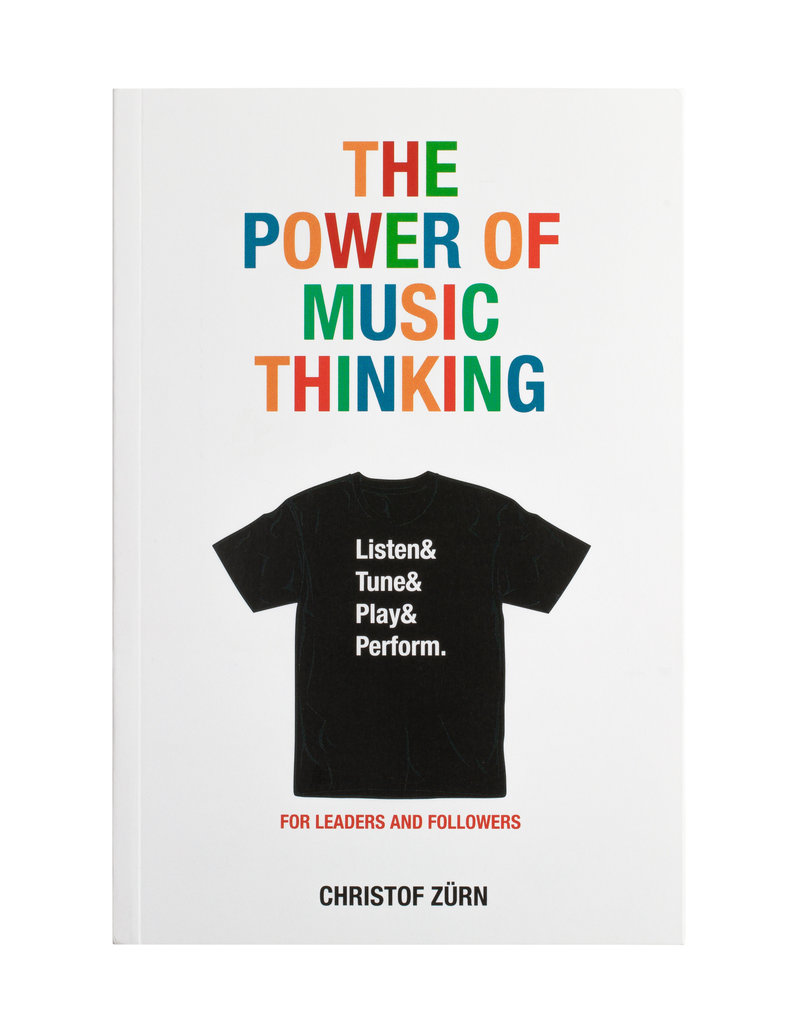Learn more about Music Thinking and the Music Thinking Framework.
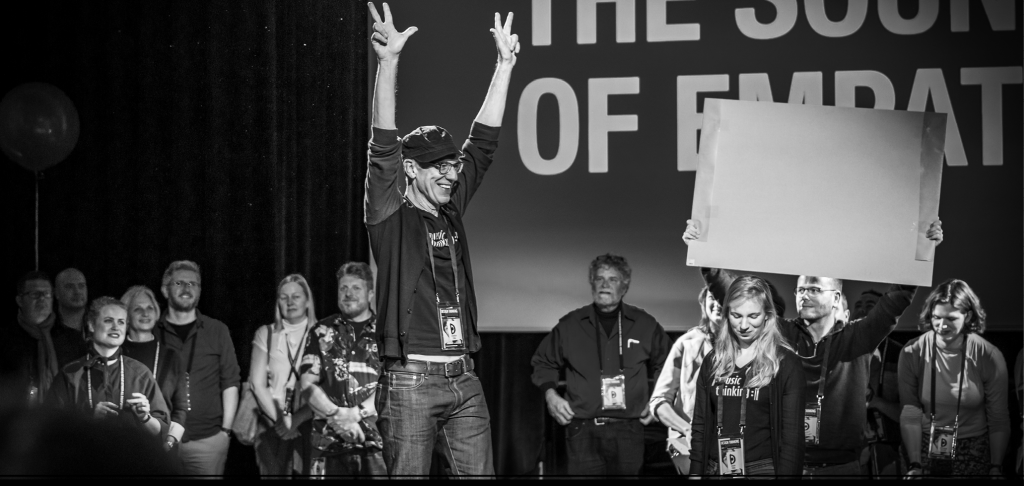
Music Thinking is a mindset to think from diverse perspectives at the same time and to get inspired to work in meaningful collaborations above silos. It supports you in integrating Agile methodologies, Design Thinking and Service Design with Branding and Organisational Change.
The basic idea of music thinking was developed while Christof Zürn was working as a Service Designer, Creative Director, Design Thinking Facilitator and Management Consultant.
The same patterns and questions were repeated during all those years, working with diverse clients from different countries.
- How can we be more creative as a business?
- How can we genuinely be more people-centric?
- Who are we as an organisation?
- What is the best way to communicate so that everybody knows how we work and what to do?
- How can we operate a more flexible and transformative business?
- How can we consistently deliver and continuously surprise our stakeholders?
These basic questions led to the Six Cues of Music Thinking.
The Six Cues of Music Thinking
- JAMMIN’
This cue is all about ideas, information, listening, sensing and collecting data from all kinds of sources. On the other hand, Jammin’ is the driving force of creativity, exploration and creation based on the input from all the other cues.
- EMPATHY
Empathy is the people-centred cue to see with the eyes of your stakeholders in their context and environment. Empathise and search for insights that matter. The two sides are listening and understanding.
- PERSONALITY
The cue to work from the heart of your organisation. Work from your why and brand values to the holding space you provide for your stakeholders. That’s why this cue has two sides: to be and to become.
- SCORE
The cue to visualise your decisions in the way that everyone has a ‘lead sheet’ of how to operate. The two sides of this cue are to show and to do. This means you need to have a vision and clear instructions on how to reach this.
- AGILITY
The cue to decide how to work together in which constellations and when to do what. The two sides of this cue are to learn and to change. Together with Jammin’, this is the realisation duo.
- REMIX
The cue to getting it all together under the given circumstances is based on the other cues. The two sides of this cue are to deliver and to live. There is a time when you have to deliver and to make iterations based on all the cues.
The cues are starting points of interventions and collaboration. They live in a dynamic challenge and solution space with Listen, Tune, Play and Perform as phases in the process. The cues build a connected system, where the different elements influence each other.
Make your choice!
Music Thinking is a framework, a mindset and a way of sustainable systemic collaboration.
After more than a decade of development, Music Thinking has come to age. An entertaining and practical book describes all facets of how to use music thinking as a leader, together with your team and organisation.
We have a podcast with more than 50 episodes of conversations with exceptional people that are also musicians. With valuable learnings and analogies between music, business and society. And there is a blog with many descriptions of practical templates that you can use right away with your team. And we have developed a variety of courses and training like our music thinking masterclass to understand and learn in a fun setting the basic ideas of music thinking.
So if you want to dive into a new approach and learn how meaningful collaboration and systemic thinking can inspire your team and organisation, you have the choice!
How the Framework works
The Music Thinking Framework is a repeating and dynamic model. It is based on the principles and learnings from my experiences as a musician and my diverse roles in various business constellations. It has four distinct parts: phases, dynamics, cues and instruments. It’s an iterative process and should not only be followed once but repeated many, many times.
Like in real life there is a rhythm, a beat or a pulse that keeps us alive.
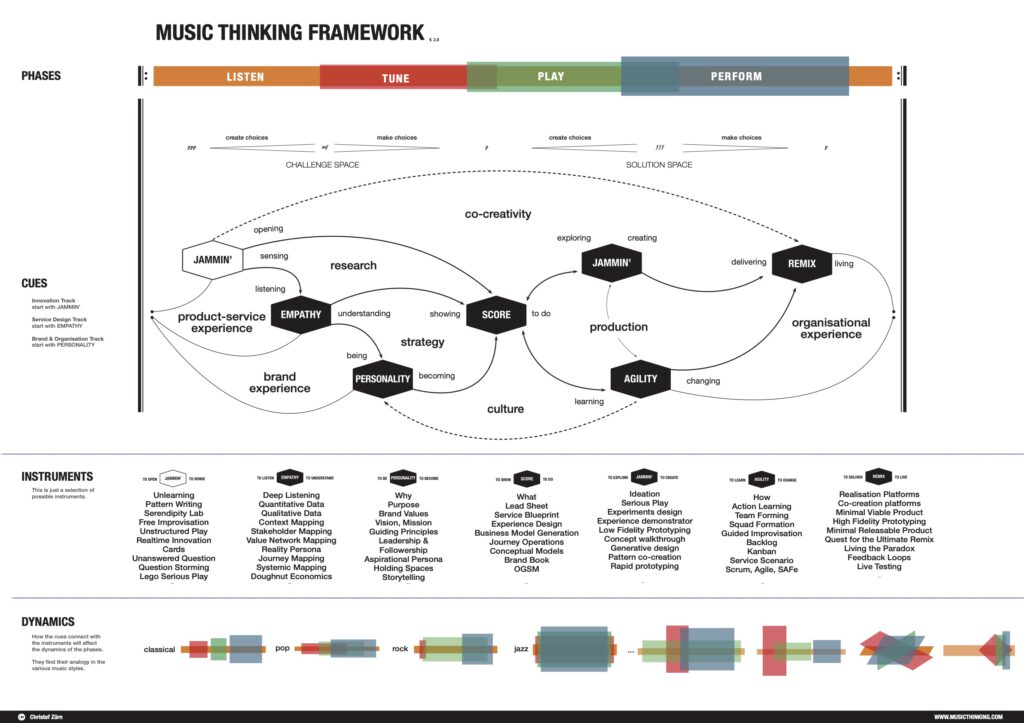
Please note that the Listen phase is active in all the other phases. This is because our ears are ‘always on’, they constantly receive information. In any organisation, there is one real question. How can we constantly listen to relevant information and respond to that?
The Music Thinking Framework operates at many different levels. In an ideal world, we would start at the beginning and go step-by-step through the journey to a successful endpoint and final REMIX. But life and business do not always work that way.
Every business is dynamic.
In many companies, leaders use the conductor of a classical orchestra as a metaphor – the one who is in charge, and everybody does what he says. We often forget that the conductor is also the coach and chief interpreter of a very detailed score (that someone else – the composer – has made). In other words, if we have a very detailed score, we need someone with a vision of the outcome to bring it all together.
But what do we do if the score is not detailed?
What do we do if the score is new to the players?
Or what if the score is constantly changing?
And if a straightforward score gives much freedom to the players?
What do we do if there is no real score but just an idea?
The analogy with classical music and, therefore the metaphor of a conductor does not work for every company. Every company is different, and we have to think further than just one style, and that’s where music can help us to see patterns in a different kind of organisation – to oversimply this statement – let’s also look into the organisation of Jazz, Pop, Rock, Hip Hop and so on.
Because every style has its own dynamics, meaning that listen, tune, play and perform will overlap in different ways based on the organisation of the cues that are inside.
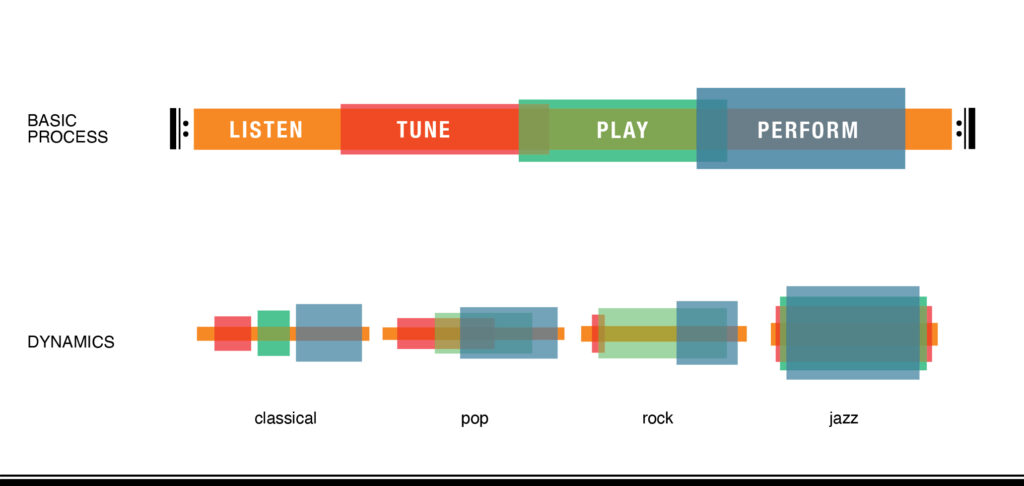
Therefore, we need new ways of understanding a score. We have to seize a score more as a guiding principle a cue and not just as something that is fixed and needs to be played well.
Actually, going forward, we need performers who connect audiences, ensemble members and the basic ideas of the music in an ever-changing, dynamic space. The concept of playing together or building on each other’s strengths from different perspectives is found from Baroque through to Jazz and Contemporary Music. What can we learn from applying these principles to how we lead 21st-century business?
Advantages of Music Thinking
In conclusion, the advantage of Music Thinking is it has many more ways of working and organising. The music itself is neither good nor bad, it’s just different. Classical Music is not better than Electronic Dance Music, and Jazz is not better than Rock, Pop or Traditional Indian Music. Every music has its own style and different dynamics in how it works. Every style has its own way of organising things; all styles can learn from each other. This helps us come to a better understanding of the different dynamics in an organisation and the diverse ways of collaborating.
So leadership shifts from being an ‘ego-system’ to an ‘ecosystem’ (Otto Scharmer), where followership is much more important than just trying to lead.
We need new ways of Followership alongside new ways of Leading – we shift the questions from who should I follow to what and how should I follow. All this is based on different interconnected cues with values, purpose and the stakeholders’ everchanging (latent) needs.
How to put the Music Thinking Framework into practice?
It needs a systematic programme to connect all the cues continuously. Every cue can use different methods (I call instruments) for diverging or converging.
Many instruments are already known in communication, business or service design methods. For example, approaches like Presencing, Theory U (Otto Scharmer), Golden Circle (Simon Sinek) and Service Design Thinking principles and tools exist. But to connect them for meaningful collaboration, it needs more than just the tools, but also the context and connection with the cues.
For example, how is the Golden Circle of Simon Sinek distributed over three cues?
Let’s use a concrete example. In the music thinking framework, the why, how and what of the Golden Circle by Simon Sinek is distributed over three cues.
Firstly, the ‘Why’ comes from the heart of the organisation and connects with the ‘Personality’ cue.
Secondly, the ‘What’ is all the things that have to be done and are an essential part of the ‘Score’ cue.
Thirdly, the ‘How’ connects with the ‘Agility” cue, which stands for learning and change.
In conclusion, the cues Personality, Score and Agility form a triangle in the framework and should connect well to make sense of the Golden Circle. And, therefore, the culture of an organisation. This means you can impact the culture from three different cues.
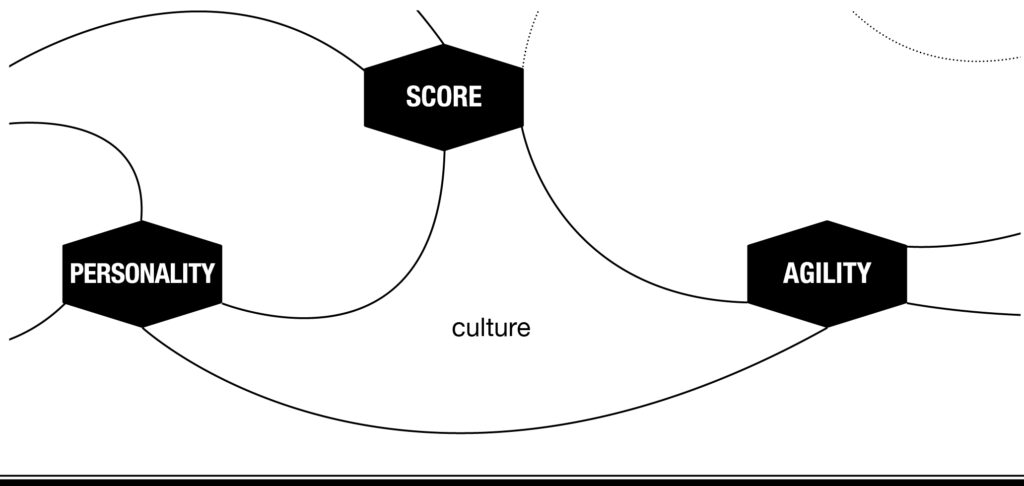
As a matter of fact, these three cues build the culture triangle. This means culture is a result of how these cues play together. It is not only essential to have your purpose and to communicate it in a clear way but also to act upon it. In this sense, culture itself cannot be changed but will be influenced by Personality, Score and Agility.
Fields of impact in triangles to organise your business
The cues build even more triangles: research, strategy, creativity, culture and realisation. So it is possible to work on these fields of impact from the different connected perspectives and scale them to the field of iteration.
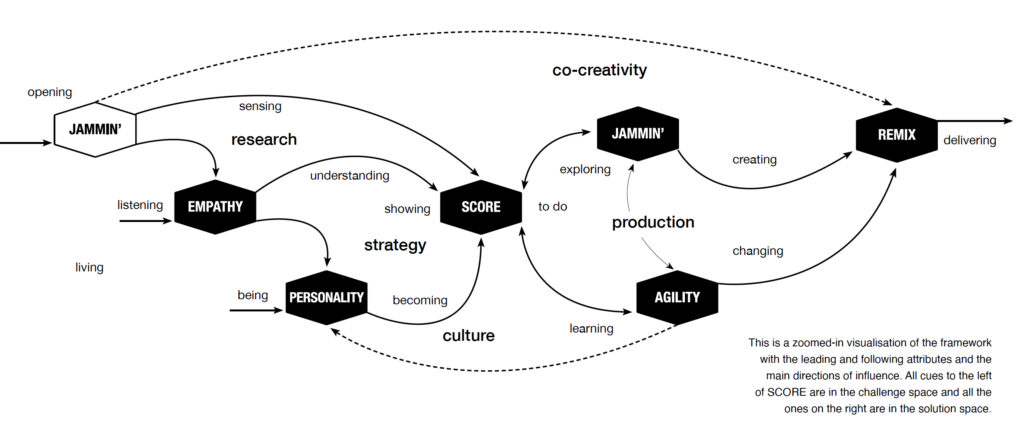
If you have read until here, congratulations, you are ready to buy the book, learn how it works and be the first Music Thinker in your organisation!
Order the book at your local or online bookstore.
With The Power of Music Thinking, you can orchestrate your talented team like a symphony, jam together like a rock band, or improvise like a jazz ensemble. Discover how to integrate Agile Methodologies, Design Thinking, and Service Design with Branding and Organizational Change.
Music Thinking moves through four phases: Listen, Tune, Play, and Perform. You and your team navigate together within and among these phases using six interrelated cues.
Depending on how you play your instruments and in what combination, for how long and how intensely, you will find different dynamics to address any challenge and create a masterwork of business solutions.
Jammin’, Empathy, Personality, Score, Agility, and Remix prompt teams to play such various innovation instruments as Branding, Design Thinking, Service Design, Agile Methodologies, Organisational Change, and Systemic Design. Find it at your favourite local or online bookstore.
More about Music Thinking
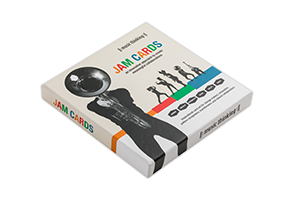 We invite you to read more about the Jam Cards. See how they can help you to introduce music thinking into your organisation and use them in a Serendipity Lab or on- and offboarding session.
We invite you to read more about the Jam Cards. See how they can help you to introduce music thinking into your organisation and use them in a Serendipity Lab or on- and offboarding session.
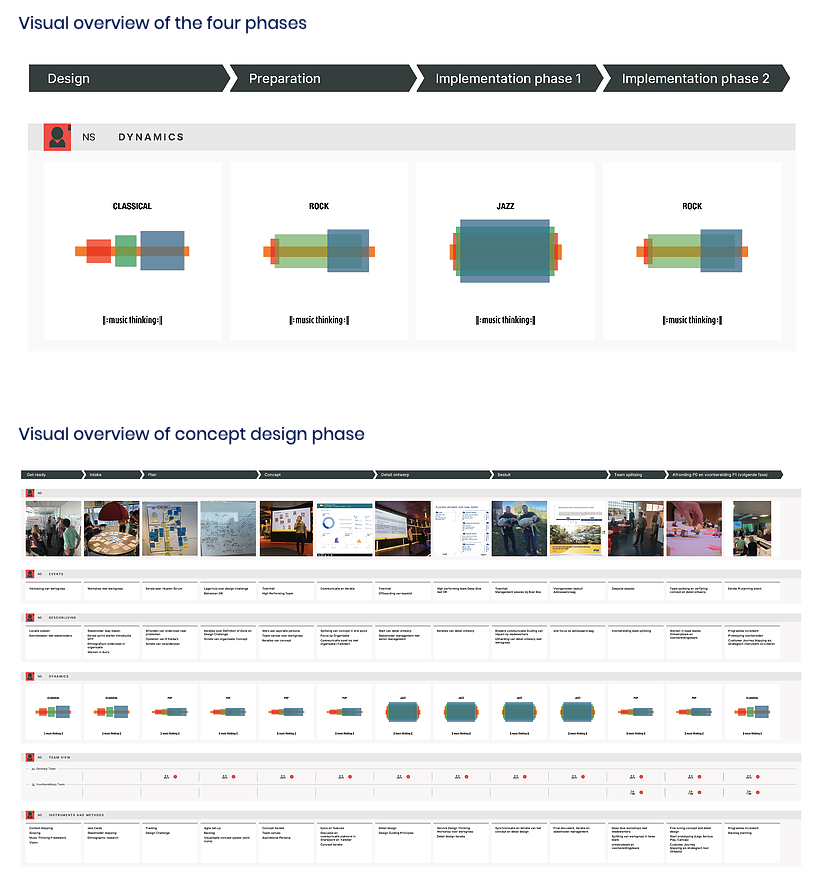 Moreover, find out how the dutch cooperative FAEBRIC used music thinking, the music thinking framework and jam cards. Their case is about a collaborative transformation programme at the Dutch railways.
Moreover, find out how the dutch cooperative FAEBRIC used music thinking, the music thinking framework and jam cards. Their case is about a collaborative transformation programme at the Dutch railways.
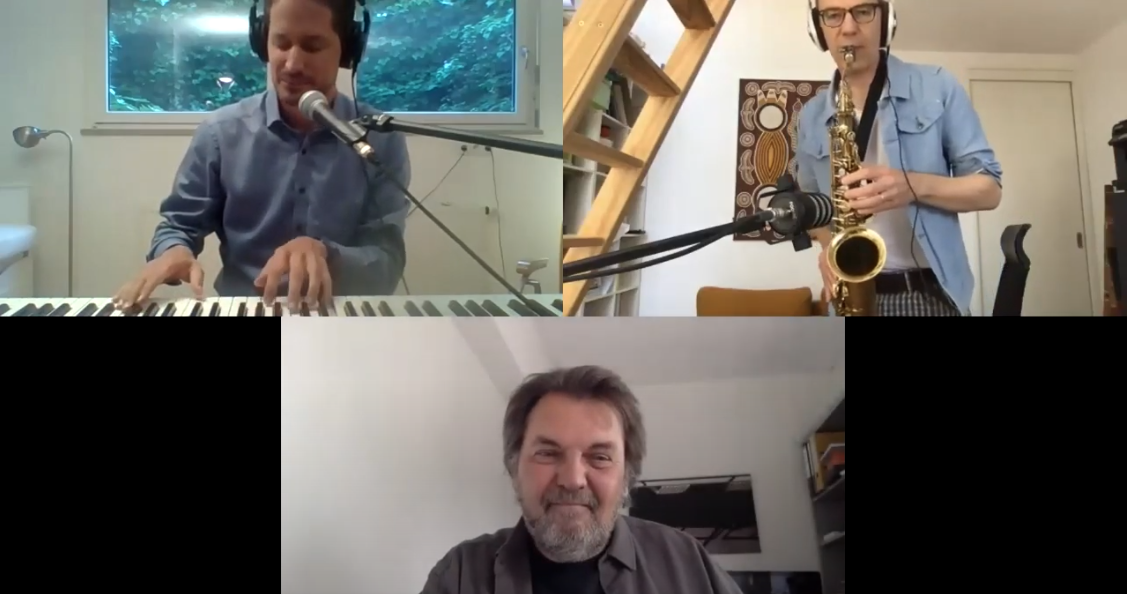 Read our blog post with examples of workshop’s, thoughts about the analogy between music and business. For instance, the blog post about the University of Krems and Business improvisation. This is interesting in the VUCA world we live in.
Read our blog post with examples of workshop’s, thoughts about the analogy between music and business. For instance, the blog post about the University of Krems and Business improvisation. This is interesting in the VUCA world we live in.
… or see our detailed offering of workshops, training and programmes
“Music Thinking is the quest for the ultimate remix of empathy & strategy; plan & performance; thoughtfulness & playfulness; inspiration & transpiration; business & the arts. But first off, it is a new way of thinking about genuine and meaningful collaboration.” Christof Zürn
Christof Zürn
Contact us for possibilities to integrate music thinking into your leadership style, your team or your organisation.

